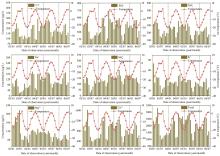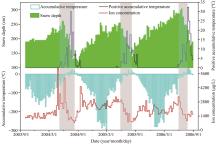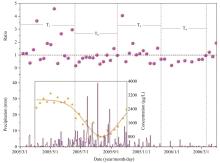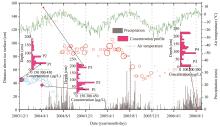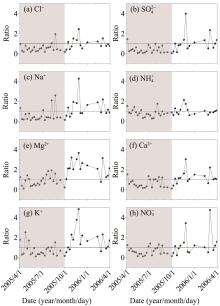Sciences in Cold and Arid Regions ›› 2022, Vol. 14 ›› Issue (2): 91–99.doi: 10.3724/SP.J.1226.2022.2020-210077.
Influence of meteorological elements on chemical evolution of snow and ice of Urumqi Glacier No. 1, eastern Tianshan Mountains
XiaoNi You1( ),ZhongQin Li2,LiXia Wang1
),ZhongQin Li2,LiXia Wang1
- 1.Tianshui Normal University, Tianshui, Gansu 741001, China
2.State Key Laboratory of Cryospheric Sciences, Northwest Institute of Eco-Environment and Resources, Chinese Academy of Science, Lanzhou, Gansu 730000, China
|
Anja E, Margit S, Heinz WG, 2001. Meltwater-induced relocation of chemical species in Alpine firn. Tellus, 53B: 192-203. DOI: 10.1034/j.1600-0889.2001.d01-15.x .
doi: 10.1034/j.1600-0889.2001.d01-15.x |
|
|
Bales RC, Davis RE, Stanley DA, 1989. Ion elution through shallow homogeneous snow. Water Resources Research, 25(8): 1869-1877. DOI: 10.1029/WR025i008p01869 .
doi: 10.1029/WR025i008p01869 |
|
|
Cong ZCZ, Kang SKS, Zhang YZY, et al., 2015. New insights into trace element wet deposition in the Himalayas: amounts, seasonal patterns, and implications. Environmental Science and Pollution Research, 22(4): 2735-2744. DOI: 10.1007/s11356-014-3496-1 .
doi: 10.1007/s11356-014-3496-1 |
|
|
Costa D, Pomeroy JW, 2019. Preferential meltwater flowpaths as a driver of preferential elution of chemicals from melting snowpacks. Science of the Total Environment, 662: 110-120. DOI: 10.1016/j.scitotenv.2019.01.091 .
doi: 10.1016/j.scitotenv.2019.01.091 |
|
|
Costa D, Sexstoned GA, Pomeroy JW, et al., 2020. Preferential elution of ionic solutes in melting snowpacks: Improving process understanding through field observations and modeling in the Rocky Mountains. Science of the Total Environment, 710(2020): 136273. DOI: 10.1016/j.scitotenv.2019. 136273 .
doi: 10.1016/j.scitotenv.2019. 136273 |
|
|
Eichler A, Schwikowski M, Gaggeler WH, 2010. Meltwater-induced relocation of chemical species in alpine firn. Tellus, 53B: 192-203. DOI: 10.1034/j.1600-0889.2001.d01-15.x .
doi: 10.1034/j.1600-0889.2001.d01-15.x |
|
|
Franz KJ, Hogue TS, Sorooshian S, 2008. Operational snow modeling: addressing the challenges of an energy balance model for national weather service forecasts. Journal of Hydrology, 360(1-4): 48-66. DOI: 10.1016/j.jhydrol.2008.07.013 .
doi: 10.1016/j.jhydrol.2008.07.013 |
|
|
Georg J, Moore RD, Russell S, et al., 2012. Distributed temperature-index snowmelt modelling for forested catchments. Journal of Hydrology, 420: 87-101. DOI: 10.1016/j.jhydrol.2011.11.045 .
doi: 10.1016/j.jhydrol.2011.11.045 |
|
|
Graeter KA, Osterberg EC, Ferris DG, et al., 2018. Ice Core Records of West Greenland Melt and Climate Forcing. Geophysical Research Letters, 45(7): 3164-3172. DOI: 10.1002/2017GL076641 .
doi: 10.1002/2017GL076641 |
|
|
Hou SG, Qin DH, 2002. The effect of postdepositional process on the chemical profiles of snow pits in the percolation zone. Cold Regions Science and Technology, 34(2): 111-116. DOI: 10.1016/S0165-232X(01)00065-9 .
doi: 10.1016/S0165-232X(01)00065-9 |
|
|
Isaksson E, Pohjola V, Jauhiainen T, 2001. A new ice-core record from Lomonosovfonna, Svalbard: Viewing the 1920-97 data in relation to present climate and environmental conditions. Journal of Glaciology, 47(157): 335-345. DOI: 10.3189/172756501781832313 .
doi: 10.3189/172756501781832313 |
|
|
Jeonghoon L, Feng XH, Eric SP, et al., 2008. Modeling of solute transport in snow using conservative tracers and artificial rain-on-snow experiments. Water Resources Research, 44(2): 1-12. DOI: 10.1029/2006WR00547 .
doi: 10.1029/2006WR00547 |
|
|
Iizuka Y, Igarashi M, Kamiyama K, et al., 2002. Ratios of Mg2+/Na+ in snowpack and an ice core at Austfonna ice cap, Svalbard, as an indicator of seasonal melting. Journal of Glaciology, 48(162): 452-460. DOI: info:doi/10.3189/172756502781831304 .
doi: info:doi/10.3189/172756502781831304 |
|
|
Kaufmann P, Fundel F, Fischer H, et al., 2010. Ammonium and non-sea salt sulfate in the EPICA ice cores as indicator of biological activity in the Southern Ocean. Quaternary Science Reviews, 29(2010): 313-323. DOI: 10.1016/j.quascirev.2009.11.009 .
doi: 10.1016/j.quascirev.2009.11.009 |
|
|
Khodzher TV, Golobokova LP, Maslenikova MM, et al., 2020. Chemistry of snow and ice cores along the ice flow lines at Lake Vostok (Antarctica). Geochemistry, 80(3): 125595. DOI: 10.1016/j.chemer.2019 .
doi: 10.1016/j.chemer.2019 |
|
|
Koerner RM, 1997. Some comments on climatic reconstructions from ice cores drilled in Areas of high melt. Journal of Glaciology, 43(143): 90-97. DOI: 10.1017/S0022143000002847 .
doi: 10.1017/S0022143000002847 |
|
|
Kotlyakov VM, Arkhipov SM, Henderson KA, 2004. Deep drilling of glaciers in Eurasian Arctic as a source of paleoclimate records. Quaternary Environments of the Eurasian North, 23(11-13): 1371-1390. DOI: 10.1016/j.quascirev. 2003.12.01 .
doi: 10.1016/j.quascirev. 2003.12.01 |
|
|
Laluraj CM, Thamban M, Naik SS, et al., 2011.Nitrate records of a shallow ice core from East Antarctica: atmospheric processes preservation and climatic implications. The Holocene, 21(2): 351-356. DOI: 10.1177/0959683610374886 .
doi: 10.1177/0959683610374886 |
|
|
Li ZQ, Edwards R, Mosley-Thompson E, et al., 2006. Seasonal variability of ionic concentrations in surface snow and elution processes in snow-firn packs at the PGPI site on Urumqi glacier No. 1, eastern Tien Shan, China. Annals of Glaciology, 43(1): 250-256. DOI: 10.3189/172756406781812069 .
doi: 10.3189/172756406781812069 |
|
|
Lilbæk G, Pomeroy JW, 2010. Ion enrichment of snowmelt runoff water caused by basal ice formation. Hydrological Processes, 22(15): 2758-2766. DOI: 10.1002/hyp.7028 .
doi: 10.1002/hyp.7028 |
|
|
Marsh P, Pomeroy JW, 1999. Spatial and temporal variations in snowmelt runoff chemistry, Northwest Territories, Canada. Water Resource Research, 35: 1559-1567. DOI: 10.1029/1998WR900109 .
doi: 10.1029/1998WR900109 |
|
|
Sharma A, Kulshrestha UC, 2020. Wet Deposition and Long-range Transport of Major Ions Related to Snow at Northwestern Himalayas (India). Aerosol and Air Quality Research, 20(6):1249-1265. DOI: 10.4209/aaqr.2019.06.0279 .
doi: 10.4209/aaqr.2019.06.0279 |
|
|
Sun SW, Kang SC, Guo JM, et al., 2018. Insights into mercury in glacier snow and its incorporation into meltwater runoff based on observations in the southern Tibetan Plateau. Journal of Environmental Sciences, 68: 130-142. DOI: 10. 1016/j.jes.2018.03.033 .
doi: 10. 1016/j.jes.2018.03.033 |
|
|
Thompson LG, Mosley-Thompson E, Henderson KA, 2015. Ice-core palaeoclimate records in tropical South America since the Last Glacial Maximum. Journal of Quaternary Science: Published for the Quaternary Research Association, 15(15): 377-394. DOI: 10.1002/1099-1417(200005)15:4<377::AID-JQS542>3.0.CO;2-L .
doi: 10.1002/1099-1417(200005)15:4<377::AID-JQS542>3.0.CO;2-L |
|
|
Torsten M, Frank W, 2011. Modeling the elution of organic chemicals from a melting homogeneous snow pack. Water Research, 45(12): 3627-3637.DOI: 10.1016/j.watres.2011. 04.011 .
doi: 10.1016/j.watres.2011. 04.011 |
|
|
Tripathee L, Kang S, Huang J, et al., 2013. Ionic composition of wet precipitation over the southern slope of central Himalayas, Nepal. Environmental Science and Pollution Research, 21(4): 2677-2687. DOI: 10.1007/s11356-013-2197-5 .
doi: 10.1007/s11356-013-2197-5 |
|
|
Tripathee L, Guo J, Kang S, et al., 2019. Measurement of mercury, other trace elements and major ions in wet deposition at Jomsom: The semi-arid mountain valley of the Central Himalaya. Atmospheric Research, 234: 104691. DOI: 10. 1016/j.atmosres.2019.104691 .
doi: 10. 1016/j.atmosres.2019.104691 |
|
|
Van de wal RSW, Mulvaney R, Isaksson E, 2002. Reconstruction of the historical temperature trend from measurements in a medium length borehole on the Lomonosovfonna Plateau, Svalbard. Annals of Glaciology, 35: 371-378. DOI: 10.3189/172756402781816979 .
doi: 10.3189/172756402781816979 |
|
|
Wang FT, Li ZQ, You XN, 2006. Seasonal evolution of aerosol stratigraphy in Urumqi glacier No. 1 percolation zone, eastern Tien Shan, China. Annals of Glaciology, 43: 245-249. DOI: 10.3189/172756406781812041 .
doi: 10.3189/172756406781812041 |
|
|
Williams MW, Tonnessen KA, Melack JM, et al., 1991. Sources and spatial variation of the chemical composition of snow in the Tien Shan, China. Annals of Glaciology, 16: 25-32. DOI: 10.1017/S0260305500004778 .
doi: 10.1017/S0260305500004778 |
|
|
Wolff EW, Hall JS, Mulvaney R, et al., 1998. Relationship between chemistry of air, fresh snow and firn cores for aerosol species in coastal Antarctica. Journal Geophysical Research, 1031(D9): 11057-11070. DOI: 10.1029/97JD02613 .
doi: 10.1029/97JD02613 |
|
|
Woods RA, 2009. Analytical model of seasonal climate impacts on snow hydrology: continuous snowpacks. Advances in Water Resources, 32(10): 1465-1481. DOI: 10.1016/j.advwatres.2009.06.011 .
doi: 10.1016/j.advwatres.2009.06.011 |
|
|
You XN, Dong ZW, 2011. Deposition process of dust microparticles from aerosol to snow-firn pack on Glacier No. 1 in eastern Tianshan Mountains, China. Journal of Earth Science, 22(4): 460-469. DOI: 10.1007/s12583-011-0200-y .
doi: 10.1007/s12583-011-0200-y |
|
|
You XN, Li ZQ, Wang LX, 2015. The transport of chemical components in homogeneous snowpacks on Urumqi Glacier No.1, eastern Tianshan Mountains, Central Asia. Journal of Arid Land, 7(5): 612-622. DOI: 10.1007/s40333-015-0131-z .
doi: 10.1007/s40333-015-0131-z |
|
|
Yukiyoshi I, Manabu N, Shuichi H, 2011. Influence of rain, air temperature, and snow cover on subsequent spring-snowmelt infiltration into thin frozen soil layer in Northern Japan. Journal of Hydrology, 401(3-4): 165-176. DOI: 10.1016/j.jhydrol.2011.02.019 .
doi: 10.1016/j.jhydrol.2011.02.019 |
|
|
Zhang NN, He YQ, Pang HX, 2010. Preliminary study of transformation of snow to ice and ion elution during ablation period at a typical temperate glacier region. Journal of Glaciology and Geocryology, 32(3): 505-513. DOI: http://ir.casnw.net/handle/362004/8183. (in Chinese)
doi: http://ir.casnw.net/handle/362004/8183. |
| No related articles found! |
|
||

